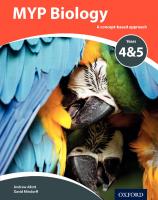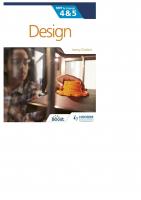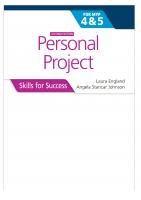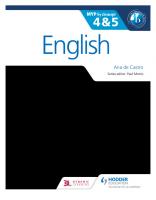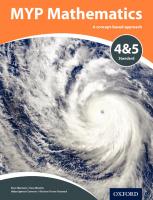IB MYP 4 and 5 Physics 0198375557, 9780198375555
Drive achievement in the MYP and strengthen scientific confidence. Equipping learners with the confident scientific unde
159 113 245MB
English Pages [324] Year 2018
Recommend Papers

- Author / Uploaded
- William Heathcote
File loading please wait...
Citation preview
Years
4&s
Years
4&s ,$r, t,
fr "i
r-
tr
'' lt:
L'
,,
"F;t
\r
t *
hi
{
.
oxroRD IJNIVERSITY PRBSS
Great Clarendon Street, Oxford, OX2 6DB United Kingdom
Oxford University Press is a department of the University of Oxford. It furthers the University's objective of excellence in research, scholarship, and education by publishing worldwide. Oxford is a registered trade mark of Oxford University Press in the UK and in certain other countries @
Oxford University Press, 2018
The moral rights
ofthe authors have been asserted
First published in 2018
All rights reseryed. No part of this publication may be reproduced, stored in a retieval system, or transmitted, in any form or by any means, without the prior permission in writing of Oxford University Press, or as expressly permitted by law, by licence or under terms agreed with the appropriate reprographics rights organization. Enquiries concerning reproduction outside the scope ofthe above should be sent to the Rights Department, Oxford Universiry Press, at the address above. You must not circulate this work in any other form and you must impose this same condition on any acquirer
British Library Cataloguing in Publication Data Data available 978-0-19-837sss-s
10987 6s4327
n
Mrx
*",tnrJm*"" {C 5--*h rsccoozzas
Paper used in the production
ofthis book is a natural, recyclable product made fiom wood grown in sustainable forests. The manufacturing process conforms to the environmental regulations of the country of origin. Printed in Great Britain by Bell and Bain Ltd. Glasgow
Actrorowledgements We are grateful to the authors and publishers for use of exffacts fiom their titles and in particular for the following: Kuldip Acharya and Dibyendu Goshal: 'Flower Inspired Thunder Protecting Umbrella' published in the 2016 Proceedings ofthe International Conference on Modeling, Simulation and Visualization Methods (MSV'16); EDITORS: Hamid R. Arabnia, Leonidas Deligiannidis, Fernando G. Tinetti; CSREA Press; ISBN: 1-601 32-443-X, 2016. Sabine Begall et al: 'Magnetic alignment in grazing and resting cattle and deer' from Proceedings ofthe National Academy ofSciences of the United States of America, volume 105 (36), 13451-13455, 09/09/2008. Copyright (2008) National Academy of Sciences, U.S.A. Reproduced by permission of PNAS. The publishers would like to thank the following for permissions to use
their photographs:
Cover image: Shutterstock. p2 ('I): Science & Sciety Picture Library/SsPl/Getty lrnages; p2 (B): Author photo: p3 (D: Mopic/Alamy Stock Photo: p3 (B): Mopic/Shuttestock; p4: Aurcra Photos/Almy Stock Photo: p5 (I): DR GARY SETTLES/SCIENCE PHOTO LIBRARY; p5 (B): Ihe Prht Collector/Almy Stock Photo; p6: Wortd History Archive/Alamy Stock Photo: p12: Science Photo Library/Alamy Stock Photo: p15 (R): E.R. Degginger/Almy Stock Photoi p15 (L): GARY DOA(Alamy Stock Photo: P16: Ivica Drusany/Shuttestock; p17: Idna Falkanfavshuttemtocki p2O: Corbis: p21: Science History Images/Almy Stock Photol p23: Peter Prcbst/Almy Stock Photo: p24 (B): cimluca Curti/Shuttestock; p24 (I): Hemdorff/Shutterstock; p25 (I):Joytullshutterstock; p25 (B): Stefan Pircher/Shutterstock; p26: Michael Taylor/Shuttestock p27 (IR): Andrey Amyagovi Shutte$tock p27 (L): Photodisc/Getty Images; p28: crmger Historical Picture Archive/Alamy Stock Photo; p3O (C): Jorisvo/Shutterstock p31: Mircnov/Shuttertock: : Boris Rabtsevich/ Shuftestock p33: Tim UR/Shuftestock; p35: Haryigit/Shuftestock; p37: Room the Agency Mobile/Almy Stock Photo; : Ama Omelchenlo/Shutterstock; p42:J HIME/ShutteEtGk; Ir44: EADWEARD MUYBRIDGE COTIECTION/ KTNGSTON MUSEUM/SCmNCE PHCrIO LIBRARY;
p45 (IR): tgoNteroovic/Shuttestock: p45 (L): MIDDIE TEMPLE UBRARY/SCIENCE PHOTO IIBRARY; pas (B): NK Smford/Almy Stock Photo: p46: DAVID PARKER/SCIENCE PHOTO LIBRARY; p49: DoodleDmce/Shuttestmk; p54: Cleufotos/Shuttestock p55: E$rptim
Studio/ShuttentocK; P57: NASMS,VSTSCVHIGH.Z SI,PERNOVA SEARCH TEAM/ SCIENCE PHOTO LIBRARYT p59: EMILIO SEGRE VlSllAL ARCHIVES/AMERICAN INSTITUIE OF PIIYSICS/ SCIENCE PHOIO IJBRARY: p6O: Paul Reet/Shuftestock p62: Art DirectoN & TRIP/Almy Stmk Photo; p63 (fl,): Joao Virissimo/Shuttestock; p63 (IR): Andrcy N Bannov/Shuttertock; p63 (B): MIKKELJUULFNSEN/SCIENCE PHOTO UBRARY; p64: Oliver Hoftnmn/Alamy Stock
Photo; P65 (I): LilKar/Shufterstock; p65 (B): Cyo Bo/Shuttestock; p66: ChristopherJ. Moris/ Cetty Images: p67: FRANS I"{NTING, MINT IMAGLS/SCIENCE PHOTO LIBRARY: p68: \4/ENN Ltd/Alamy Stock Photo: p69: Maros Bauer/Shutterstock p7O: William Heathcote; p75 (IR): JOEL AREM/SCIENCE PHOIO LIBRARY; p75 [IL): Andrca Paggiaro/Shutterstock: p79 (TR): Kevin Smith/ iDesign Picsicorbis; p79 (TL): Tristan3D/Shutterstock: p8O; NAS.A/ESA/STSCI/J. CLARKE, U.MICHIGAN/ SCIENCE PHOTIO LERARY; p81: Arto Hakola/Shurterstock; p82: Richard Peterson/Shutterstock; p84 (I): Karen Kaspar/Alamy Stock Photoi p84 (B); 3Dstock/ Shutterstock; p85 (1): SAKARET/Shutterstock; p85 (B): Archive Image/Alamy Stock Photo; p85 (B): ShutterstocqFedorov Oleksiy; p87 (C); Kajomyot/Shutterstock; p86: Zoia Kostina/ Shutterstock: p87 (BL): Floridastock/Shutterstock; p87 (BR): Ulrich Willrnunder/ Shutte$tock; p88: TriryShutterctock; : Pascal Goetgheluck/Science Photo Library; p89: Galina BaNkaya/ShutteNtock p93 (I): Kotenko Oleksandr/Shuftestock p93 (B): KPG Paytess/ Shufte$tock; p94: Photodisc/Getty Images; p95: Photodisc/C{tty Images; p97 (I): Andrew lambeft Photognphy/Science Photo Library; p97 (B): NattakitJeerapatrnaitree/Shuttesrock: p99: Denis Scott/Corbis: p102: ciedre vaitekune/Shutte$tock; p1O3: Vicspacewalker/ Shutterstock; p106 (I): Tatiana Popova/Shutterstock; pl06 (B): Aslysun/Shutetstock; pl07 (f):Javaman/Shutterstock; pl07 (B): Shutterstock; p1O8: Chris HowesMild Places Photography/Alamy Stock Photo; p1O9 CI): Pjrstudio/Alamy Stock Photo; p1O9 (B): Trif? Shutte$tock; p111 (1L): Et/Getty Images: p111 (IC): Getty Images: pl11 (IR): Photodisc/ Getty Inages: p112: OUP; p114: Almy Stock Photo; p113: Steve Noakes/Shutterstock; p115 (f): Jakc Rennaker/Shuttestock; pl17 (fL): Ken Tannenbaumishuttestock; pl17 (IR): Alamy Stock Photo; p1l7 (C): Koktranchikov/Shufteretock: pl15 (B): World History Archive/ Alamy Stock Photo; p1l7 (BL): withcod/Shutterstock; p117 (BR): Kampot Taepmich/ Shufterstock; pl18 (TL): Shutterstock; p118 (Cf): Miki Simukevicius/Shuttemtocki p118 (CB): Tawmsal(Shuttestock pl18 (IR): Jonathan larsen/Diadem lmages/Alamy Stock Photo: pl16: Lola1960/Shuttestock; pl18 (B): Eric M. Jones/NASA; p120: Racefotos20o8/ Shutterstock: p123: MBI/Almy Stock Photo: p122: Marythepooh/Shuttestock]-p127 (Ll: Kryvenok Anastasiia/Shutterstock; pl27 (LC): MubusT/Shuttestock; p127 (RC): Shutterstock; pl27 (R): Lasse KdsteNen/Shutterstock; pl31: Andrci Nekmssov/Shuttestock pl33: Shutterstock; p134 (L): Shuftestock; p134 (R): Iceink/Shufterstock; p135 (I1): Alamy Stock Photo; p135 (IR): Shutterstock: pl35(B): Shuttelstock; p136: RcB Ventues/Supersrocki Alamy Stock Photo; p137 (IL): Stocktrek Images, Inc./Alamy Stock Photo: p137 (BR): INTERFOTO/A]any Stock Photo; p138 (fL): Chmgsgallery/Shufterstock; p138 (BR): NASA ArchiveiAlamy Stock Photo; p139: Evereft Historicalishuftestock p142 (B): Chronicle / Alamy Stock Photo; p142 (I): Sheila Terry/Science Photo Library; p143 (II,): Phoenix Photosetting/q2A Media; p143 (BL): Paul Feam / Alamy Stock Photo; p143 (BR): Lukasz Janyst/Shutte6tockt p1a14: Georgios Kollidas/Shutterstock; p15O (I): Stocktuek Images, Inc./ Alamy Stock Photo; p151 (I): Granger Historical Picture A(hive/Alamy Stock Photo; p151 (B): Muk Garlic(Science Photo Library: p156 (D: Marykitishunerstock: p156 (B): yousang/ ShufteNtock; p157 (I): solameven/Shutterstock; p157 (B): Everett Historicavshutterstock; p159 (B): Aija Lehtonen/Shuttestock; p159 (I): Nicku/Shuttemtock; p158: Haloviss/ Shutteretock: pl51: Petu An/Shutterstock; p166: Cotlection Abecasis/Science Photo library; p169 (L): Shutterstock: p169 (R): Gun/Shufterstock; p170: Sciencephotos / Atamy Stock Photo: pl71: Stockphoto Mani4shuttestock; pl71: Srockphoto Mada/Shutterstock; :
Willyam Bmdberry/Shutterstock; : Nuwat Phansuwan/Shutterstock; p173 (I): William Heathcote; p173 (B): Deklofenak/Shunerstock; p174: Wearset Ltd; p178 (I): Sergio cutierez Getino/Shutte6tock; p178 (B): Juan Aunion/Shutte$tock; p 179 (f): PRISMA ARCHIVO/A1amy Stock Photo; p 179 (B): Andrey Amyagov/Shutte$tock; p18O: Science History Images/Alamy Stock Photo: p181 (f): Andrey WShuftestock: p181 (B): ArhMilVshutterstock: p182: World History Archive/Alamy Stock Photo; pl83: Corbis; pl84: SCIENCE SOURCE/SCIENCE PHOTO UBRARY: p186 (I): ROYAL ASTRONOMICAL SOCETY/SCIENCE PHOTO LIBRARY; p186 (B): Caltech/Mn&lco Lab/SCIENCE PHOTO UBRARY; p187: ROYAI ASTRONOMICAI SOCIEIY/ SCIENCE PHOTO LIBRARY; p189 (I): Roland Oster/Shutrerstock: p189 (B): Glphotostock/ SCIENCE PHCrIO LIBRARY; p190: ANDREW I"AMBERT PHOTOGRAPITY/SCIENCE PHCnO LIBRARY; p192: Roberto Lo Savio/Alamy Stock Photo: p193: Pedrosala/Shunerstock; p194: Notety/Shutterstock: p197: GlPhotoStockiSCIENCE PHOTO UBRARy; pl98: CyberEa( Shutterstock; pl99: NYPL/SCIENCE SOURCE/SCIENCE PHOTO LIBRARY: p2OO: Asharkyui Shutterstock: p2O1: Waldenstroem/Shuttestock: p2O3: AsharkF/Shutterstock; p204 (fL): William Heathcote supplied; p204 (TR): Thinkstock/cetty Images: pz(N (B): Mlchaet CrawFord-Hick/Alamy Stock Photo; p2O5 (I): Fotokon/Shuttestock p205 (B): MARK SYKES/ SCIENCE PHOIO LIBRARY; p2O6: W.A. Shaman/Milepost 92 1/2l0orbis: p2O7 (I\: Jeff Gynme/ Shutterstock p2O7 (B): Tappasan Phurisamrit/Shunerstock; p2O8 (L): Cpphotoimages/ Shutterstock; p2O8 (R): Ian Woolcock/Shufte$tock p2O9: Tv/Shufterstock; p21O (!: WitR/ Shuttestock; p21O (B): IM_photo/Shutterstock; p211: Corey Fod/123RF; p212: William Heattrcote supplied; p213: Rich Carey/Shuttestock; p214: Paulo Oliveira/Alamy Stock Photo; p218: Cameover/Alamy Stock Photo; p221 (IL): Outdoorsman/Shutte6tocki p221 (IR): Danita Delimont/Alamy Stock Photo; p222 (IR): Modelist/Shutterstock; p222 (BL): Image Point Fr/Shutterstock; p223: Damsea/Shutterstock; p225 (1R): Nick Stubbs/Shutterstock; p225 (BL): Martin Parratt/Shuttestock: p226: Duncanl8g0/istockphoto: p228: Christopher Elwellshutterstock; p232 (fL): Science History Inages/Alamy Srock Photo; p232 (BR): Hulton Archive/Getty Images; p233 (I): Shutterstock; p233 (B): Vladimir Wrangey Shutterstock; p234: Anyaivanova/Shuttestock; p235 (I): Kostsov/Shuttestock; p235 (B): Thelefty/Shufterstock; p237 (BL): Dmitry Yashkin/Shutterstock; p237 (BR): Melisi Shutterstock; p238 (fL): Nitr/Shutte6tock; p238 (IT.): Jovan Vitmovski/Shutterstock; p238 (BL): Muk Hemeid/Shutterstock; p238 (BR): Kaband/Shutterstock: p239 (IR): Gm Chabnan/ Shutterstock; p239 (CL): Duntri Mehik/Shuttestock p239 (B): Photodisc/Getty Images; p241: Singkhm/Shutterstock; p243 (CL): Andrew M. Allport/Shutterstock; p243 (CR): Kajomyot Wildlife Photognphy/ShutteNtock; p244: Cephas Picture Library/Alamy Stock Photo: p248 (TL): Anat Chant/Shutterstmk; p2fl): Bertold Werkmann/ShutteEtock; p251: Mdkus Gam/Shuttestock p252: Francesco R Iacomilo/Shutte6tock p254: Kaitong Yepoon/Shutterstock; p256 (fL): Wiliam Heathcote: p256 (IR): Margilet/Shutterstock p256 (B): EkT Studio/ShutteNtock: p257 (BR): Elenabum/Shutterstock p257 (BL): Kichigin/ Shuttentock; p258: Science History lnages/Alamy Stock Photo; p259 (IL): Apiguide/ Shutte$tock: p259 (CR): Eveleen/Shuttestock; p259 (B): Willim Heathcore; p26O (L): Rattiya Thongdumhyru/Shutterstock; p26O (C): Amin Rose/Shutterstock p260 (R): Corbis; p261 (B): Ilya Andriyanov/Shutterstock: p262: MilanB/Shutterstock; p265 (BL): William Heathcote; p265 (BR): William Heathcote: p266: Reload Design/Shutrerstockj p267 (Bl: Science Photo Library; p269: itsmejust/Shuttertock: p27O: Aleksmdr Yu/Shufters tocki p277: Vlad1988/Shuttestock: p28O: MilcelcleDens/Shuttemtock; p282: Deco/Alamy Stock Photo; p285: Sergey Nivens/Shutterstocki p286: Overcreqshuttestock; p289: MSATES4STSCI/ SCIENCE PHOTO LIBRARY
Artwork by Aptara Corp. md
OUP.
Contents lntroduction
iv
How to use this book
v
Mapping grid
1 2 3 4 5 6 7 8 9
Models
vi 2
Interaction
24
Evidence
44
Movement
62
Environment
84
Function
106
Form
134
Consequences
156
Development
178
10 Transformation 11 Energy 12 Patterns
256
Glossary
290
lndex
307
Answers
204
232
www.oxford seconda ry.com/myp-science-s u pport
lntroduction The MYP Physics course, like all MYP Sciences, is inquiry based. To promote conceptual understanding, the MYP uses key concepts and related concepts. Key concepts represent big ideas that are relevant across disciplines. The key concepts used in MYP Sciences are change, relationships and systems. Related concepts are more specific to each subject and help to promote more detailed exploration. Each chapter is focused on one of the twelve related concepts and one key concept. Each chapter opens with ways in which the related concept is explored in other disciplines. This structure will help to develop interdisciplinary understanding of the concepts. After the interdisciplinary opening pages, the concepts are introduced more deeply in relation to the specific content of the chapter. The objectives of MYP Science are categorized into four criteria, which contain descriptions of specific targets that are accomplished as a result of studying MYP Science:
A. Knowing and understanding B. Inquiring and designing C. Processing and evaluating D. Reflecting on the impacts of science
Within each chapter, we have included activities designed to promote achievement of these objectives, such as experiments and data-based questions. We also included factual, conceptual and debatable questions, and activities designed to promote development of approaches to learning skills. The summative assessment found at the end of each chapter is framed by a statement of inquiry relating the concepts addressed to one of the six global contexts, and so is structured similarly to the MYP eAssessment. For those students taking the eAssessment at the end of the MYP programme, the International Baccalaureate Organization provides a subject-specific topic list. Great care has been taken to ensure all of topics from the list are covered within this book.
Overall, this book is meant to guide a student's exploration of Physics and aid development speciflc skills that are essential for academic success and getting the most out of this educational experience.
How to use this book To help you get the most of
your book, here's an overview of its features.
Concepts, global context and statement of inquiry
The key and related concepts, the global context and the statement of inquiry used in each chapter are clearly listed on the introduction page
Activities A range of activities that encourage you to think further about the topics you studied, research these topics and build connections between physics and other disciplines.
Worked examples Worked examples take a step-by-step approach to help you translate theory into practice.
Experiments Practical activities that help you prepare for assessment criteria B & C
Data-based questions These questions allow you to test your factual understanding of physics, as well as study and analyse data. Data-based questions help you prepare for assessment criteria A, B E C.
i std
I ^P'
\>\-. Hokusai's'The Great Wave off Kanagawa'is one of the most iconic images of a wave
Summative assessment Statement of inquiry: A good nrodrl can sirrrplill'and illunrinatc our rrnderstandinc oI conrplcx phcr.rontena.
lntroduction A nucle rrs is so tiny, that is ltarul 1o stlld), e r1terintenta111,; it is irnyrossiblc lo Llse corrvcr-rtional tcchnicirres srrch .rs a nticroscol'lc. This assessnrent is bascd on experinrenls to deternrinc thc sizc ol the nrrclcus in alon-rs.
r
,#,ffi
nl
t7
ln this image, electrons with a small wavelength have been used to see the atoms of gold with a scanning electron microscope. Electrons with a much smaller wavelength would be required to observe the nuclei of these atoms
ffi Probing the atom As a general rule, waves can only be used to sce ol-rjects that are larger than tl-re wavelength of the waves. Since the wavelength of visible light is about a thousand times larger than an atom, ar-r optical rnicntscope
cannot be used to see ir-rdividual atoms.
The nuclei of atonrs are much smaller still ar-rd so we reqtrire waves with very snrall wavelengths to probe the nucleus of atonts. Electrons demonstrate both a wave-like and a particle-like behavior and since the wavelength of l-rigl-r energy electrons can be very small, they can be used to probe the nuclei of atorns.
In an experiment to measure the size of the nucleus of a gold atom, the wavelength of the electrons is 2 x l0tt'm and they are traveling
atlxlOsms-r.
1. 2,
Calcr-rlate the frequency of the electron wave. [2]
Calculate the time period of the electron waves. Il
I
MODELS
3.
ls
t,
The target nucleus in the experiment was gold which has a mass number of.197 and an atomic number of.79.
a)
Describe this nucleus in atomic notation. (The chemical symbol for gold is Au.) [2]
b)
How many neutrons are in the gold nucleus? [2]
4,
Another isotope of gold has a mass number of 200. Explain what is meant by an isotope and how these nuclei differ from the gold197 nuclei. [3]
5.
Explain why the two gold isotopes have similar chemical properties. [3]
6.
The electron waves are transverse. Describe the difference between a transverse wave and a longitudinal wave. [2]
lnvestigating the nuclear radius A series of experiments is designed to investigate other nuclear radii.
7.
Explain which of the following you think would be the most suitable independent variable for the experiment: atomic
8.
number
mass
number
number of electrons. [3]
Write a suitable hypothesis for this experiment. [4]
g, One suggestion is to investigate
and measure the different radii of the isotopes of gold. Discuss whether this is a good suggestion. [5]
l0.Explain why it might be important to use the same wavelength o{ electrons when measuring the differing nuclei. [3]
al a, The liquid drop model of the nucleus 1
1.
The graph below shows the nuclear radius of some nuclei in femtometers (l fm = I x l0-r5 m). 7
6 5 U'
tt
4
G
.! 3
I
o,
()
2
I o
"1
.
l
0 50 100 150 200 250 atomic mass
a)
Would you classify the trend of the graph as directly proportional, linear or non-linear? [1]
b)
Draw a line of best fit on a copy of the graph.
c)
Use the graph to predict tl-re radius of a nucleus of
[t]
tungsten- 184. [21
12.A model of the nucleus called the liqr-rid drop model suggests rhat the volume of a nucleus is directly proportional to the number of protons and neutrons in it. A graph of the volume of nuclei against mass number is shown below. 400 350
o o,
ct
300
250 200
a
G
(, (, 150 100
a
50 a
0
0 50
100 150 200 250
atomic mass
a)
Using your value of the radius of tungsten-I84 from the first graph, calculate the volume of this nucleus. (Assume that the nucleus is a sphere.) [4]
b) How would you classify the trend of this graph? [I] c) Add this data point to a copy of the graph. It] d) Discuss whether the liquid drop model of the nucleus
appears
to be a good n-rodel. You should refer to the graph in your answer. [5]
()
Describing the atom 13. The experiment described
in this section can be described as
nuclear physics since it is the study of the nucleus. However, the words "nuclear" and "atomic" are sometimes thought to refer to nuclear weapons and can cause fear as a result. Write a short paragraph explaining the structure of an atom without using the words "nuclear" or "atomic". [5] 14. Our increased knowledge of the structure of the atom and
its nucleus have been a signiflcant advance in scientiflc understanding. Identify the benefits and limitations that these scientiflc advances have brought us and justify whether this progress has been beneficial to humankind. II0]
The emblem of the
lnternational Atomic Energy Agency (IAEA) features a diagram of the Rutherford
modelof the atom.The IAEA promotes the safe, secure and peaceful use of nuclear science and technology
lnteraction we experience when we are young can shape our personality later in life. How is modern technology affecting the way in which we learn to interact with each other?
V
In ali music, interaction between the musicians is essential.ln jazz music the musicians may be improvising, but by interacting with each other they are able to make a coherent piece of music. How do the musicians interact and communicate without speaking?
.&
f\
u
r:!:i&*fr&' -
-{
tt
{ \ t"
trl
I
!
i:
",1.-
-.
' 'i
.,,:.:.:4...,:.:a:.1.:,:.-
'go,i
*
24
-3ii;e#&FagY9gn##ry*::irf
'1
,-
]?r
\
-t\ \
)\F
{D
='.
\\
r ",
-lu t
i,*
Q,'q *
lo' a
r
d
I G ai.
I
I
ffi{*'r '\ iF-'-'" --
ta
f ,hr
)
1
'---r--.
t
a )
1--
t
t!
/ #l
i
.;
-d
4q
I
i-l
I
* l!
r) A
v
rE&
A basic model itr economics consists of the interaction between people and companies. people get jobs and Iorm part of the workforce and consume goods while companies en-rploy a workforce ar-rd strpply goods. Wl'rat happens when one part of this interaction fails?
different ways; some are predators while other animals are hunted. Other interactions between animals can be syrnbiotic where both anin'rals gain from the relationship. The reef shark allows other fish near it to feed on parasites and dead skin. The fish get food and in return the shark gets a good clean. Are there any examples of humans forming symbiotic relationships with other animals?
I
NTE RACTI
ON
lntroduction Key concept: Relationships
Related concept: Interaction Global context: Identities and rclationshi1'ls
V
Physicists strive to explain the fundamental interactions of matter. This particle collision in the Large Hadron Collider is part of the ongoing experiments to unravel how these interactions take place
Without interactions, the universe would be a very dull place. Nothing could possibly change without interactions to cause that change to take place. However the universe started out would be how the universe would remain, forever. A universe with interactions, on the other hand, is a complex system ol many objects all interacting and influer-rcing each other. For this reason, the key concept of this chapter is relationships. Scientists believe that all forces in the universe can be explained through only four fundamental interactions: electrornagnetisrn, gravity, the strong interaction and the weak interaction. The strong and the weak interactions have an extremely short range - the strong interaction only acts over a few femtometers ( I femtometer is l0 I' m) and the weak interaction only acts over ranges about I00 times smaller than that. The short range of the weak and the strong interactions make them very hard to observe directly. The electromagnetic and gravitational interactions, on the other hand, have an unlimited range (although they get weaker at larger distances). This makes them easier to study.
The electromagnetic interaction accoLtnts for the way light is emitted and the way we see it. It accounts for magnetism and electromagnetic induction. In this chapter we shall investigate electrostatic forces which are another part of the electromagnetic interaction.
The way in which the universe changes is governed by fundamental interactions of matter.
otrr experience ol the universe often takes gravity for granted. For nrtrch of history hnnrans have dreamed of escaping gravity ar-rcl flyir-rg, and technology has enabled us to do so, however wc often forget that the force of gravity is our most fundanrental intcraction with the planel nprtn whicl-r we live.
A
The electromagnetic
interaction allows
us
to
see and interact with the
outside world
A
This picture shows the first unattached spacewalk which took place in 1984. The Earth still exerts a gravitational force on the astronaut but, because there are no other forces acting, he feels weightless. The sensation would be much like freefall, but with no air resistance and no frame of reference to show that he is falling
Whilc electrostatic and gravitational inleractictr"rs cause forces which are observable, the mechanisrn by which they work is invisible to us. This makes it I'rard for scientists to explain how these interactions work. Indeed even today, explaining l-row gravity ar-rd electromagnetisnr are relatecl is one oI tl-re toughest challenges facing theoretical physicisrs.
we interact with the outside world through the electrostalic forces and gravity. Because these forces govern ollr perceptior-r of the world and our interaction with it, the global context o1 the chapter is identities and relationships. The interactions we experience throtrghout our lives with the outside world shape our relationshilr with it ancl so create tl're identities within whicl-r we live.
INTERACTION
@
How does an apple help to explain gravity?
depicts the story of Newton sitting under an apple tree and an apple landing on his head. The story is popular despite the fact that it almost certainly did not happen!
}iEIYTOI{ AND IIIS
PTPE.
There is a story that Isaac Newton was sitting under an apple tree when an apple fell on his head. It is suggested that this event caused him to think about gravity and how the force that pulled the apple downwards was the same force that was responsible for keeping the Moon in orbit around the Earth and the planets in orbit around the Sun. This event is unlikely to have actually happened and Newton never wrote of it at the time, although he seems to have developed the story and embellished it Iater in his life. However, the story was helpful to Newton in explaining how gravity worked. He reasoned that an apple fell directly downwards towards the center of the Earth because the Earth must exert a force. He also concluded that the apple should also draw the Earth up towards it, although the apple, being much smaller, would have a tiny and unmeasurable effect.
The importance of Newton's idea about gravity was that he thought that the same force that pulled the apple down to the ground also affected the way the planets moved. This meant that one force was able to account for many different effects over a large range of scales.
In order to account for the way in which gravity could cause the planets to orbit the Sun, Newton deduced that gravity's interaction would get weaker as it extended outwards away from the Earth. He reasoned that the force of gravity must be an inverse square law, that is, the force of gravity is inversely proportional to the square of the distance between the centers of mass of the two objects. This means that doubling the distance between two objects would cause the force of gravity between them to fall to a quarter of its initial strength.
€r
F
A
iM,
The gravitationalforce between two objects is proportional to the two masses, M,and Mr, and inversely proportional to the square of the
distance between their centers of mass
Newton's law of gravitation can be written
as
GMM '---vl--2
D--
where M, and M, are the masses of the two objects between which the force of gravity F is acting, r is the distance between the centers of mass of the two objects and G is a constant with a value of 6.67 x l0-u m3 kg-r ,-2.
1.
Use Newton's law of gravitation to calculate the force of gravity that would act between you and someone standing next to you. What does the size of this force say about how we notice the interaction of gravity?
2.
The graph below shows how the force acting on a I kg object changes with its height above rhe Earrh's surface. How high above the Earth's surface would you have to go for the gravitational force to have halved from its original strength on the ground? 10
r-
-]--l
-I
i
z,
I
8
i
C'
o,
EI
o
6
b0 .:



